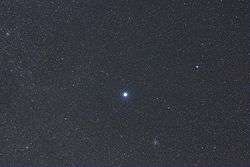Messier 41
Messier 41 (also known as M41 or NGC 2287) is an open cluster in the constellation Canis Major. It was discovered by Giovanni Batista Hodierna before 1654 and was perhaps known to Aristotle about 325 BC.[4] M41 lies about four degrees almost exactly south of Sirius, and forms a triangle with it and Nu2 Canis Majoris—all three can be seen in the same field in binoculars. The cluster itself covers an area around the size of the full moon.[5] It contains about 100 stars including several red giants, the brightest being a spectral type K3 giant of apparent magnitude 6.3 near the cluster's center, and a number of white dwarfs.[6][7][8] The cluster is estimated to be moving away from us at 23.3 km/s.[1] The diameter of the cluster is between 25 and 26 light years. It is estimated to be 190 million years old, and cluster properties and dynamics suggest a total life expectancy of 500 million years for this cluster, before it will have disintegrated.[3]
| Messier 41 | |
|---|---|
 Messier 41 is seen 4 degrees south of Sirius in Canis Major | |
| Observation data (J2000 epoch) | |
| Constellation | Canis Major |
| Right ascension | 06h 46.0m[1] |
| Declination | −20° 46′[1] |
| Distance | 2,300 ly[2] (710 pc) |
| Apparent magnitude (V) | 4.5[1] |
| Apparent dimensions (V) | 38 arcmin[2] |
| Physical characteristics | |
| Radius | 12.5 ly |
| Estimated age | 190 million yrs[3] |
| Other designations | M41,[1] NGC 2287[1] |
Walter Scott Houston describes the appearance of the cluster in small telescopes:[9]
Many visual observers speak of seeing curved lines of stars in M41. Although they seem inconspicuous on photographs, the curves stand out strongly in my 10-inch [reflecting telescope], and the bright red star near the center of the cluster is prominent.

 M41 in an 8" telescope
M41 in an 8" telescope
References
- "M 41". SIMBAD. Centre de données astronomiques de Strasbourg. Retrieved 2006-12-21.
- "Messier Object 41". SEDS. Retrieved 2009-12-10.
- Stoyan, Ronald (2008). Atlas of the Messier Objects: Highlights of the Deep Sky. Cambridge University Press. p. 171. ISBN 9780521895545.
- M41 possibly recorded by Aristotle
- Kambic, Bojan (2009). Viewing the Constellations with Binoculars: 250+ Wonderful Sky Objects to See and Explore. New York, New York: Springer. p. 230. ISBN 978-0-387-85355-0.
- Koester, D. Reimers, D. (1981), "Spectroscopic identification of white dwarfs in Galactic Clusters I. NGC2287 and NGC3532", Astronomy & Astrophysics, 99, L8-11
- De Laet, Rony (2011). The Casual Sky Observer's Guide: Stargazing with Binoculars and Small Telescopes. New York, New York: Springer. pp. 95–97. ISBN 978-1-4614-0595-5.
- Dobbie, P, Day-Jones, A, Williams, K, Casewell, S, Burleigh, M, Lodieu, N, Parker, Q, Baxter, R, (2012), "Further investigation of white dwarfs in the open clusters NGC2287 and NGC3532", Monthly notices of the Royal Astronomical Society, 423, 2815–2828
- Houston, Walter Scott (2005). Deep-Sky Wonders. Sky Publishing Corporation. ISBN 978-1-931559-23-2.
External links
| Wikimedia Commons has media related to Messier 41. |
- Messier 41 on WikiSky: DSS2, SDSS, GALEX, IRAS, Hydrogen α, X-Ray, Astrophoto, Sky Map, Articles and images
- Messier 41, SEDS Messier pages
- NightSkyInfo.com – M41
- M41 Hires LRGB CCD Image
